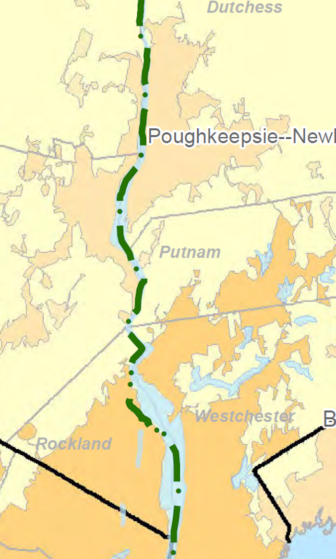Hudson Valley municipalities fear contamination
The developer of a $6 billion transmission line that will run under parts of the Hudson River while carrying electricity from Canada to New York City said testing shows the project will not harm municipalities north of the Highlands that rely on the river for drinking water.

Transmission Developers Inc. on May 4 released the findings of tests conducted in September using a simulated intake pipe and a jet plow similar to the one that will carve a trench in the riverbed for an underwater cable from Columbia County through the Highlands and into Rockland County.
The Albany-based firm described the disturbance of sediment during testing “as brief and temporary” and said that the area near the simulated intake recovered within two hours. It said it developed the test in collaboration with the Hudson River Drinking Water Intermunicipal Council.
The council, also known as the Hudson 7, is a coalition of five towns (Esopus, Hyde Park, Lloyd, Poughkeepsie and Rhinebeck), the City of Poughkeepsie and the Village of Rhinebeck. Each uses the river for drinking water and worries that polluted sediment from trenching will infiltrate intake pipes.
Transmission Developers also said samples of sediment along the line’s route tested below state standards for a range of toxic chemicals and metals, except for one taken near Hyde Park.
While that sample showed elevated levels of dioxins and polychlorinated biphenyls (PCBs), the sediment would not pose a risk to Hyde Park, whose intake pipe is 1,100 feet from the transmission line’s route, said TDI. Will Davie, TDI’s senior vice president marine, said the company “will continue to work closely” with the municipalities.
“With their collaboration and extensive input, we have demonstrated that we can safely install this clean-energy infrastructure in a way that does not impact local water supplies,” he said.
Gary Bassett, the Village of Rhinebeck mayor and chair of the Hudson 7, said on Tuesday (May 9) that the test results provided “reasonable assurance” that installing the transmission line will not jeopardize drinking water, but he also emphasized that each municipality can decide how it wants to use the data.
In July, Bassett urged the Dutchess County Industrial Development Agency (IDA) to deny TDI’s request for $105.5 million in property-tax breaks over 30 years, plus $13.6 million in sales-tax and $1.3 million in mortgage-tax relief.
A letter he sent to the agency highlighted fears that the project would disperse contaminated sediment into water intakes. Faced with opposition, TDI withdrew its application to the IDA. Two months later, the company began testing.
Bassett said the Hudson 7 “drove them [TDI] to do something they would have never done in terms of trying to protect our drinking water.”
“We don’t want this in the river, but given what was done in terms of pilot testing and the mitigation that we can put in place, I, as the owner of a water plant, am reasonably assured that there’s minimal risk,” he said.
The state announced in December the start of construction on the 339-mile transmission line. When finished, it will tie into a grid operated by Hydro-Quebec, a Canadian company that says nearly all its electricity comes from renewable sources, and enter the U.S. through cable buried under Lake Champlain.
Some sections will be buried on land, but 60 percent of the project will be underwater. Along with Lake Champlain and the Hudson River, sections will run under the Harlem River before the line terminates at a converter station in Astoria, Queens, that will connect to Con Edison’s grid.
It is expected to supply 1,250 megawatts of energy to the city and help fulfill the state’s goal of reducing greenhouse gas emissions by 40 percent and supplying 70 percent of electricity through renewable sources by 2030.

It’s a Direct Current (DC) transmission line-safer than your 120V outlet in your house. The disturbance when trenching the sedimentation to lay just one cable will be minimal compared to the other contaminants being in the water in the water already. The disturbance will be settled almost immediately due to the pressure on the riverbed.
We’ve been told over and over that things were safe — I believe they will say anything to have their project developed. Please give me some reasons why this is beneficial to us? Why does New York City get electricity from Canada? [via Instagram]
Transmission of renewable energy into the places that need it is a major issue. Interconnection backlogs are long for solar and wind projects. This line will help supply hydro and wind energy where needed.
This is just one of multiple projects underway right now in our region. There are environmental impacts. If we want enough renewable energy to supply major cities, we need to get it there. [via Instagram]
What about the effects of the electricity running through those lines on marine life? [via Facebook]